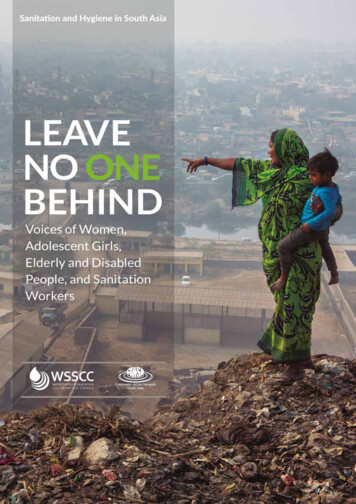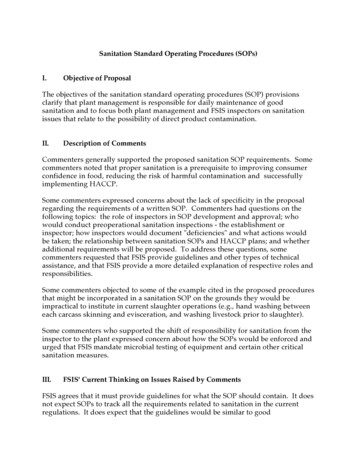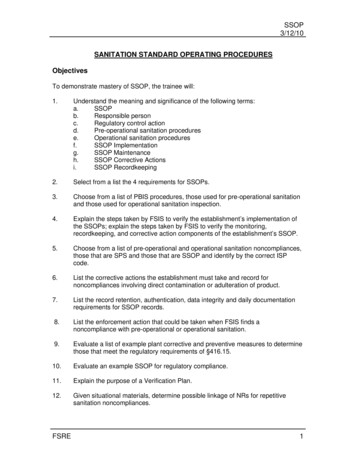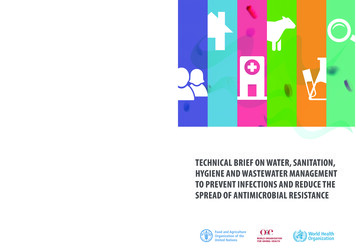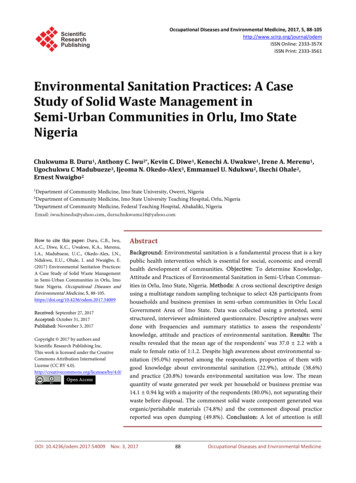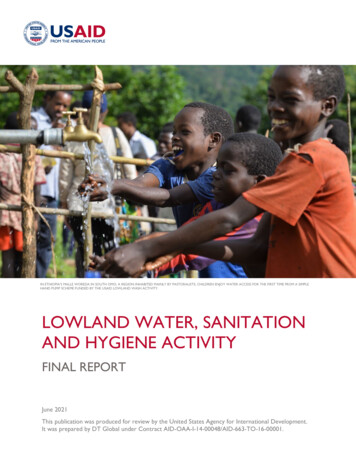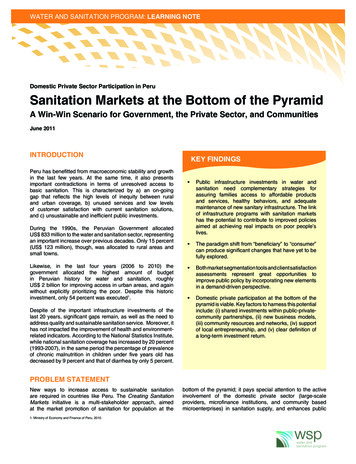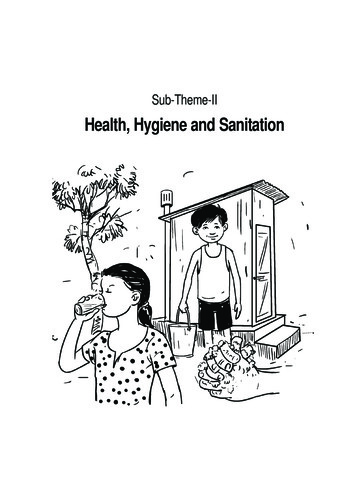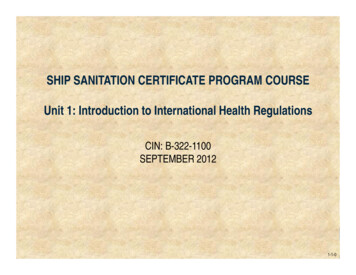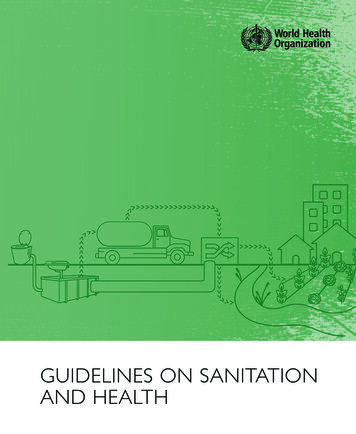
Transcription
GUIDELINES ON SANITATIONAND HEALTH
GUIDELINES ON SANITATIONAND HEALTH
Guidelines on sanitation and healthISBN 978-92-4-151470-5 World Health Organization 2018Some rights reserved. This work is available under the Creative Commons Attribution-NonCommercial-ShareAlike 3.0 IGO licence (CC BY-NC-SA 3.0 3.0/igo).Under the terms of this licence, you may copy, redistribute and adapt the work for non-commercial purposes, provided the work is appropriately cited,as indicated below. In any use of this work, there should be no suggestion that WHO endorses any specific organization, products or services. The use ofthe WHO logo is not permitted. If you adapt the work, then you must license your work under the same or equivalent Creative Commons licence. If youcreate a translation of this work, you should add the following disclaimer along with the suggested citation: “This translation was not created by theWorld Health Organization (WHO). WHO is not responsible for the content or accuracy of this translation. The original English edition shall be the bindingand authentic edition”.Any mediation relating to disputes arising under the licence shall be conducted in accordance with the mediation rules of the World Intellectual PropertyOrganization.Suggested citation. Guidelines on sanitation and health. Geneva: World Health Organization; 2018. Licence: CC BY-NC-SA 3.0 IGO.Cataloguing-in-Publication (CIP) data. CIP data are available at http://apps.who.int/iris.Sales, rights and licensing. To purchase WHO publications, see http://apps.who.int/bookorders. To submit requests for commercial use and queries onrights and licensing, see http://www.who.int/about/licensing.Third-party materials. If you wish to reuse material from this work that is attributed to a third party, such as tables, figures or images, it is yourresponsibility to determine whether permission is needed for that reuse and to obtain permission from the copyright holder. The risk of claims resultingfrom infringement of any third-party-owned component in the work rests solely with the user.General disclaimers. The designations employed and the presentation of the material in this publication do not imply the expression of any opinionwhatsoever on the part of WHO concerning the legal status of any country, territory, city or area or of its authorities, or concerning the delimitation of itsfrontiers or boundaries. Dotted and dashed lines on maps represent approximate border lines for which there may not yet be full agreement.The mention of specific companies or of certain manufacturers’ products does not imply that they are endorsed or recommended by WHO in preference toothers of a similar nature that are not mentioned. Errors and omissions excepted, the names of proprietary products are distinguished by initial capital letters.All reasonable precautions have been taken by WHO to verify the information contained in this publication. However, the published material is beingdistributed without warranty of any kind, either expressed or implied. The responsibility for the interpretation and use of the material lies with the reader.In no event shall WHO be liable for damages arising from its use.Design and layout by L’IV Com Sàrl, Switzerland.Fact sheet illustrations by Rod Shaw, Water, Engineering and Development Centre, Loughborough University, UK.Printed in Switzerland
ContentsForeword viiAcknowledgements viiiAcronyms and abbreviations xExecutive summary xiiChapter 1. Introduction 1.1 The significance of sanitation for human health 1.2 Sanitation as a human development issue 1.3 Scope 1.4 Objectives 1.5 Target audiences 1.6 Health authorities mandate 1.7 Methods 1.8 Guidelines structure References 1124677789Chapter 2. Recommendations and good practice actions 2.1 Recommendations 2.2 Good practice actions References 11112026Chapter 3. Safe sanitation systems 3.1 Introduction 3.2 Toilets 3.3 Containment – storage/treatment 3.4 Conveyance 3.5 Treatment 3.6 End use/disposal 3.7 Applicability of sanitation systems References 292931343944495257Chapter 4. Enabling safe sanitation service delivery 4.1 Introduction 4.2 Components of an implementation framework 4.3 Policy and planning 4.4 Legislation, regulations, standards and guidelines 4.5 Roles and responsibilities 595959616468CONTENTSiii
iv4.6 Environmental health authorities and their role in sanitation 4.7 Delivering sanitation at local level 4.8 Developing sanitation services and business models 4.9 Fostering the sanitation services market 4.10 Management of special sanitation risks References 707475787983Chapter 5. Sanitation behaviour change 5.1 Introduction 5.2 Institutional and government responsibilities for sanitation behaviour change 5.3 Sanitation behaviours and determinants 5.4 Changing behaviours 5.5 Monitoring and learning for success References 84848485879597Chapter 6. Excreta-related pathogens 6.1 Introduction 6.2 Microbial aspects linked to sanitation 6.3 Environmental transmission of pathogens in faecal waste 6.4 Treatment and control References 100100102114120122Chapter 7. Methods 7.1 Introduction 7.2 Contributors 7.3 Scoping and question formulation 7.4 Evidence retrieval, assessment and synthesis 7.5 Evidence grading 7.6 Evidence-to-Decision (EtD) framework References 125125125126128128130132Chapter 8. Evidence on the effectiveness and implementation of sanitation interventions 8.1 Introduction 8.2 Summary and discussion of evidence 8.3 Reviews of intervention effectiveness 8.4 Reviews of implementation 8.5 Summary of evidence reviews References 133133133134141142150Chapter 9. Research needs 9.1 Pursuing a sanitation research agenda 9.2 Research agenda References 151151151157WHO GUIDELINES ON SANITATION AND HEALTH
AnnexesAnnex 1: Sanitation system fact sheets 159Annex 2: Glossary 193TablesTable 1.1: The health impact of unsafe sanitation 2Table 2.1: Evidence to recommendation table using the WHO-INTEGRATE framework 23Table 3.1: Treatment performance of containment technologies 37Table 3.2: Established wastewater treatment technologies 46Table 3.3: Established sludge treatment processes 47Table 3.4: Summary of established end use products 50Table 3.5: Applicability of sanitation systems 53Table 3.6: Examples of climate adaptation options for specific sanitation systems 54Table 4.1: Areas that may require legislation and regulation 64Table 5.1: Summary of approaches and factors for consideration in their implementation 90Table 5.2: Behavioural monitoring methods and measures 96Table 6.1: Excreta-related pathogens 105Table 6.2: Pathogen concentrations in faeces and raw sewage 116Table 6.3: Factors influencing microbial persistence 118Table 6.4: Selection of ID50 values from human challenge data 119Table 7.1: Evidence to recommendation table using the WHO-INTEGRATE framework 131Table 8.1: Summary of evidence reviews 143FiguresFigure 1.1: Transmission of excreta-related pathogens 4Figure 1.2: Sanitation service chain 5Figure 3.1: Faecal contamination risk 30Figure 3.2: Excreta flow diagram showing examples of hazardous events at each step of the sanitation service chain 30Figure 3.3: Hazardous events for permeable and impermeable containment - storage/treatment technologies 35Figure 3.4: Hazardous events for conveyance technologies 41Figure 4.1: Categorization of sanitation services 60Figure 4.2: Implementation framework for sanitation 61Figure 4.3: Example of phasing out unsafe sanitation over time 63Figure 4.4: Sanitation service chain regulatory mechanism options 66Figure 4.5: The components of the SDG sanitation ladder 73Figure 5.1: Example of behavioural determinants for open defecation 87Figure 5.2: Stages in behaviour change strategy design 92Figure 6.1: Transmission of excreta-related pathogens 103Figure 7.1: Conceptual framework for guidelines development 127Figure 8.1: Preliminary conceptual framework of the influence of inadequate sanitation on well-being 141Figure 8.2: Sanitation adoption and sustained use review framework 142CONTENTSv
BoxesBox 1.1: Sanitation and complex health outcomes: environmental enteric dysfunction 1Box 1.2: Human right to sanitation 3Box 1.3: The Sustainable Development Goals (SDGs) and sanitation 3Box 1.4: Why are guidelines on sanitation and health needed? 6Box 3.1: International Organization for Standardization (ISO) standards relevant for sanitation services 29Box 3.2: Definitions 30Box 3.3: Climate change, sanitation and health 54Box 4.1: Setting targets 62Box 4.2: Immediate preventive measures for areas at high risk of enteric disease outbreaks 81Box 5.1: Sanitation behaviour change considerations for urban settings 87Box 6.1: Antimicrobial resistance and sanitation 101viWHO GUIDELINES ON SANITATION AND HEALTH
ForewordSanitation saves lives. But history teaches us that it’s also one of the keybuilding blocks of development.Ancient civilizations that invested in sanitary improvements became healthy,wealthy, powerful societies. More recently, modernization and economic growthhave followed investments in sanitation systems.Sanitation prevents disease and promotes human dignity and well-being, making itthe perfect expression of WHO’s definition of health, as expressed in its constitution,as “A state of complete physical, mental, and social well-being, and not merely theabsence of disease or infirmity”.The right to water and sanitation is foundational to several SustainableDevelopment Goals. After decades of neglect, the importance of access to safesanitation for everyone, everywhere, is now rightly recognized as an essentialcomponent of universal health coverage. But a toilet on its own is not sufficientto achieve the SDGs; safe, sustainable and well-managed systems are required.Dr Tedros Adhanom GhebreyesusDirector-GeneralWorld Health OrganizationGlobally, billions of people live without access to even the most basic sanitation services. Billions more areexposed to harmful pathogens through the inadequate management of sanitation systems, causing people tobe exposed to excreta in their communities, in their drinking water, fresh produce and through their recreationalwater activities. The scale of need is further compounded by urbanization, climate change, antimicrobialresistance, inequality and conflict.It is with these challenges in mind WHO has developed its first comprehensive guidelines on sanitation andhealth, filling a critical gap in authoritative health-based guidance on sanitation that results in better health.While clearly setting out the need for action and providing tools and resources, these guidelines also reinvigoratethe role of health authorities as champions of sanitation.The guidelines recognize that safe sanitation systems underpin the mission of WHO, its strategic prioritiesand the core mission of ministries of health globally. I hope these guidelines will be of great practical use toministries, health authorities and implementers to make the best investments in the best interventions for thebest possible health outcomes for everyone.FOREWORDvii
AcknowledgementsGuidelines Development GroupPatrick Apoya, Consultant, Ghana; Jamie Bartram, The Water Institute at the University of North Carolina, USA;Jay Bhagwan, Water Research Commission, South Africa; Lizette Burgers, UNICEF, USA; Alfred Byigero, RwandaUtilities Regulatory Authority, Rwanda; Kelly Callahan, The Carter Center, USA; Renato Castiglia Feitosa,Fiocruz, Brazil; Thomas Clasen, Rollins School of Public Health, Emory University, USA; Oliver Cumming, LondonSchool of Hygiene & Tropical Medicine, UK; Robert Dreibelbis, Department of Disease Control, London Schoolof Hygiene and Tropical Medicine; Peter Hawkins, independent consultant, UK; Tarique Huda, InternationalCentre for Diarrhoeal Disease Research, Bangladesh; Andrés Hueso, WaterAid, UK; Paul Hunter, the Universityof East Anglia, UK; Pete Kolsky, The Water Institute at the University of North Carolina, USA; AntoinetteKome, SNV, The Netherlands; Julian Kyomuhangi, Ministry of Health, Uganda; Joe Madiath, Gram Vikas,India; Gerardo Mogol, Ministry of Health, Philippines; Guy Norman, Water and Sanitation for the Urban Poor,UK; Kepha Ombacho, Ministry of Health, Kenya; Andy Peal, independent consultant, UK; Susan Petterson,School of Medicine, Griffith University, Australia; Oscar Pintos, Asociación Federal de Entes Reguladores deAgua y Saneamiento de Argentina, Argentina; Andrianaritsifa Ravaloson, Ministry of Water and Sanitation,Madagascar; Eva Rehfuess, Center for International Health, Ludwig-Maximilians-Universität München, Germany;Virginia Roaf, Consultant, Germany; Jan-Willem Rosenboom, the Bill & Melinda Gates Foundation, USA; LindaStrande, EAWAG, Switzerland; Garusinge Wijesuriya, Ministry of Health, Sri Lanka.WHO Steering Group and reviewersMagaran Bagayoko, Communicable Diseases Cluster, Regional Office for Africa, Republic of the Congo (CongoBrazzaville); Hamed Bakir, Centre for Environmental Health Action, Regional Office for the Eastern Mediterranean,Jordan; Sophie Boisson, Department of Public Health, Environmental and Social Determinants of Health,Switzerland; Kaia Engesveen, Department of Nutrition for Health and Development; Shinee Enkhtsetseg,Regional Office for Europe; Bruce Gordon, Department of Public Health, Environmental and Social Determinantsof Health, Switzerland; Rok Ho Kim, Western Pacific Regional Office, Philippines; Dominique Legros, Departmentof Infectious Hazard Management, Switzerland; Kate Medlicott, Department of Public Health, Environmentaland Social Determinants of Health, Switzerland; Teofilo Monteiro, Communicable Diseases and EnvironmentalDeterminants of Health (CDE), Panamerican Health Organization – World Health Organization (PAHO/WHO), Peru;Antonio Montresor, Department of Control of Neglected Tropical Diseases, Switzerland; Maria Neira, Departmentof Public Health, Environmental and Social Determinants of Health, Switzerland; Payden, Regional Office for SouthEast Asia, India; Annette Prüss-Üstün, Department of Public Health, Environmental and Social Determinants ofHealth, Switzerland; Oliver Schmoll, Management of Natural Resources: Water and Sanitation, WHO EuropeanCentre for Environment and Health, Germany; Anthony Solomon, Department of Control of Neglected TropicalDiseases, Switzerland; Yael Velleman, Department of Public Health, Environmental and Social Determinants ofHealth, Switzerland; Elena Villalobos Prats, Department of Public Health, Environmental and Social Determinantsof Health, Switzerland; Astrid Wester, Department of Public Health, Environmental and Social Determinants ofHealth, Switzerland.viiiWHO GUIDELINES ON SANITATION AND HEALTH
ContributorsKelly Alexander, CARE, USA; Nicholas J. Ashbolt, School of Public Health, University of Alberta, Canada;Robert Bos, Independent Consultant, Switzerland; Val Curtis, London School of Tropical Medicine and Hygiene,UK; Matthew C. Freeman, Rollins School of Public Health, Emory University USA; Joshua Garn, University ofNevada, NV USA; Emily D. Garner, Department of Civil & Environmental Engineering, Virginia Tech, BlacksburgVA USA; Guy Hutton, UNICEF, USA; Christine Moe, Rollins School of Public Health, Emory University, USA; AmyPruden, Department of Civil & Environmental Engineering, Virginia Tech, Blacksburg VA USA; Lars Schoebitz,independent consultant, Switzerland, Gloria Sclar, Rollins School of Public Health, Emory University USA; PippaScott, i-San, UK.External reviewersRobert Chambers, Institute of Development Studies, UK; Pay Drechsel, International Water Management Institute,Sri Lanka; Barbara Evans, Faculty of Engineering, University of Leeds, UK; Darryl Jackson, independent consultant,Australia; Marion W. Jenkins, Center for Watershed Sciences, UC Davis, USA; Jon Lane, independent consultant, UK;Freya Mills, Institute for Sustainable Futures, University of Technology Sydney, Australia; Eduardo Perez, USAID/Mortenson Center in Engineering for Developing Communities, University of Colorado Boulder, USA; Jan M Stratil,Pettenkofer School of Public Health, LMU Munich, Germany; Naomi Vernon, Institute of Development Studies, UK;Juliet Willetts, Institute for Sustainable Futures, University of Technology Sydney, Australia.Technical editorLorna Fewtrell, independent consultant, UK.External support agenciesWHO gratefully acknowledges the financial support provided by the Department for International Development,United Kingdom, and the Bill and Melinda Gates Foundation for the development of these guidelines and theSwiss Agency for International Development, the United States Agency for International Development, AgenceFrançaise de Développement, the Directorate-General for International Cooperation of the Netherlands, theSwedish International Development Cooperation Agency and Norwegian Agency for Development Cooperationfor their wider support to the WHO Strategy on Water, Sanitation, Hygiene and Health.ACKNOWLEDGEMENTSix
Acronyms and 0ISOJMPLMICsMICSMoHMPNNGONTDsxAntimicrobial resistanceBehaviour Change TechniqueBiochemical oxygen demandContainer-based sanitationColony forming unitsCommunity Health ClubChild Hygiene and Sanitation TrainingConfidence intervalCommunity-led Total SanitationCombined sewer overflowDisability-adjusted life yearDemographic and Health SurveyDeveloping Markets for SanitationDeoxyribonucleic acidEvidence to DecisionGene copiesGuidelines Development GroupGrading of Recommendations, Assessment, Development and EvaluationGuidelines Review CommitteeGlobal Water Pathogen Projectfocus forming unitsHealth care facilityHuman immunodeficiency virusHealth management information systemInternally-displaced personInformation, Education and CommunicationDose at which 50% of subjects would become infected; or probability of infection 0.5International Organization for StandardizationThe WHO/UNICEF Joint Monitoring Programme for Water Supply, Sanitation and HygieneLow- and middle-income countriesMultiple Indicator Cluster SurveyMinistry of HealthMost Probably NumberNon-governmental organizationNeglected Tropical DiseasesWHO GUIDELINES ON SANITATION AND HEALTH
OPspp.STHTCIDTIPUDTWASHWHOOperation and maintenancePolymerase chain reactionPlaque forming unitsParticipatory Hygiene and Sanitation TransformationPersonal protective equipmentPathogen reduction levelQuantitative polymerase chain reactionRandomized controlled trialRibonucleic acidSanitation as a BusinessSanitation MarketingSustainable Development GoalsSchool-led Total SanitationStandard operating proceduresSeveral species within a genusSoil transmitted helminthsTissue culture infectious doseTrials for Improved PracticeUrine diversion toiletWater, sanitation and hygieneWorld Health OrganizationACRONYMS AND ABBREVIATIONSxi
ExecutivesummaryExecutive summaryIntroduction and scopeSafe sanitation is essential for health, from preventing infection to improving and maintaining mental andsocial well-being. The lack of safe sanitation contributes to diarrhoea, a major public health concern and aleading cause of disease and death among children under five years in low- and middle- income countries;poor sanitation also contributes to several neglected tropical diseases, as well as broader adverse outcomessuch as undernutrition. Lack of access to suitable sanitation facilities is also a major cause of risks and anxiety,especially for women and girls. For all these reasons, sanitation that prevents disease and ensures privacy anddignity has been recognized as a basic human right.Sanitation is defined as access to and use of facilities and services for the safe disposal of human urine andfaeces. A safe sanitation system is a system designed and used to separate human excreta from human contactat all steps of the sanitation service chain from toilet capture and containment through emptying, transport,treatment (in-situ or off-site) and final disposal or end use. Safe sanitation systems must meet these requirementsin a manner consistent with human rights, while also addressing co-disposal of greywater, associated hygienepractices and essential services required for the functioning of technologies.The purpose of these guidelines is to promote safe sanitation systems and practices in order to promotehealth. They summarize the evidence on the links between sanitation and health, provide evidence-informedrecommendations, and offer guidance for encouraging international, national and local sanitation policies andactions that protect public health. The guidelines also seek to articulate and support the role of health andother actors in sanitation policy and programming to help ensure that health risks are identified and managedeffectively.The main audience for the guidelines is national and local authorities responsible for the safety of sanitationsystems and services, including policy makers, planners, implementers and those responsible for thedevelopment, implementation and monitoring of standards and regulations. This includes health authorities and,since sanitation is often managed outside the health sector, other agencies with responsibilities for sanitation.The guidelines were developed in accordance with the processes set out in the WHO Handbook for GuidelineDevelopment.Evidence summaryThe evidence reviewed in the process of developing the guidelines suggests that safe sanitation is associated withimprovements in health, including positive impacts on infectious diseases, nutrition and well-being. In general,however, the quality of the evidence is low. This is common for environmental health research generally dueto the paucity of randomized controlled trials and the inability to blind most environmental interventions. Theevidence is also characterized by considerable heterogeneity, with some studies showing little or no effect onhealth outcomes. Heterogeneity can be expected in results from studies where, as here, there was high levelsof variability in the settings, baseline conditions, types of interventions, levels of coverage and use obtained,xiiWHO GUIDELINES ON SANITATION AND HEALTH
Executivesummarystudy methods and other factors likely to impact effect sizes. Sub-optimal effects can also be expected fromshortcomings in how sanitation interventions are implemented (i.e. problems with delivery of sanitationinterventions, sometimes even leading to implementation failure).Research needsThere is need for further research on the links between sanitation and health, and on the operation of thesanitation service chain and optimal methods for implementation. Research gaps include strategies forencouraging governments to prioritize, encourage and monitor sanitation; creating an enabling environment;improving coverage and securing correct, consistent, sustained use; estimating health impacts from sanitationinterventions; improving methods for assessing presence of and exposure to sanitation-related pathogens inthe environment; preventing the discharge of faecal pathogens into the environment along all steps of thesanitation service chain; exploring alternative designs and services, including safe emptying and managementof on-site sanitation; ensuring that proposed sanitation interventions are culturally-appropriate, respect humanrights and reflect human dignity; mitigating occupational exposures; reducing adverse ecological effects;elaborating the links between sanitation and animals and their impact on human health; and investigating theissues around sanitation and gender.Navigating the guidelinesThe Guidelines are organized as described in the table below. The recommendations and actions required toimplement them are set out in Chapter 2 following the introduction. Chapters 3 to 5 provide technical andinstitutional guidance for implementation, and Chapters 6 to 9, as well as the annexes, provide further technicalresources.Introduction, scope and objectiv
health, filling a critical gap in authoritative health-based guidance on sanitation that results in better health. While clearly setting out the need for action and providing tools and resources, these guidelines also reinvigorate the role of health
